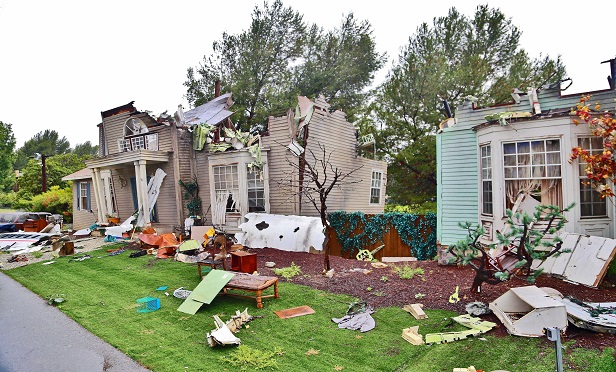 As moreinsurance stakeholders understand the risks environmental changeposes, they see the value of restoring vs. replacing after a loss.(Photo: Shutterstock)
As moreinsurance stakeholders understand the risks environmental changeposes, they see the value of restoring vs. replacing after a loss.(Photo: Shutterstock)
Climate change undoubtedly presents one of the biggestchallenges for insurers, their clients, and our society as a whole.The recent report by the Intergovernmental Panel on Climate Changestates that the expected net present value of damages from anincrease of 2°C of warming are expected to be $64 trillion by 2100.Insured losses in 2017 in the U.S. were thehighest on record, at $138 billion, due to major hurricanes andstorm events that experts link to climate change.
|Today, an increasing number of insurance stakeholders are notjust aware of the risks environmental change poses; they arechanging their practices relative to the restoration ofcontents. Insurance executives have acknowledged that'sustainably restoring contents' benefits all stakeholders,including investors, policyholders and underwriters. Any damages toinsured assets require either restoration or payout. Balance sheetsand profitability are highly exposed to whether contents are eitherrestored or replaced.
|After property damage has been sustained, typically, the firstthought a homeowner or adjuster may have is that anything damaged ought to be discarded. Thatinitial thinking poses costly consequences for homeowners, insurersand the planet.
|It's no secret that landfills are filling up fast.
|The impact of a consumer-driven, throwaway society is at acritical point given how greenhouse gases have been linked toincreasingly destructive natural catastrophes. It's a vicious cycle— contents damaged post-disaster are often discarded rather thanrestored, only to be purchased all over again.
|According to FEMA, 2005's Hurricane Katrina led to more than 99million cubic yards of debris, much of it ending up in landfills.Hurricane Michael was the last to strike during the 2018 hurricaneseason; that category 5 storm left more than 36 million cubic yardsof debris in its wake.
|The capacity of landfills in the U.S. is diminishing at a rapidrate. In 2017 alone, landfills received 11.2 million tons oftextile waste — things like clothing, bedding, andcarpeting, according to the EPA.
|The good news is that several government agencies are working tomanage natural disaster debris. The goal is to ensure thatcommunities, individuals, businesses, schools and local governmentswork together to reduce trash.
|Contents recycling
From a cost standpoint, it's better to restore than to replace.Restoration costs, on average, are typically five to 15% of anitem's value.
|The role of contents restoration supports environmentalsustainability — call it "responsible" restoration. By restoringcontents to pre-loss condition using environmentally friendlyprocesses, contractors can prevent such items from being discardedand replaced. At both the individual and business level, firmsutilizing state-of-the-art technology can restore significantlymore contents efficiently.
|Restoration doesn't just help the environment. Customers canbreathe a sigh of relief because they don't' necessarily have tolose sentimental attachments to soft contents like their clothingor hard contents like furniture, appliances and electronics.
|Cleaning green
The use of green detergents, along with state-of-the-arttechnology that can restore Category 2 and 3 claims, also helps torescue damaged contents from filling landfills. For example,proprietary wash systems require less water and use hydraulicpressure and a specific blend of environmentally friendlydetergents with no harmful chemicals, to restore contents to afood-grade clean condition. Non-caustic detergents and organicsanitizers aid in the cleaning and restoration of leather goods.Specific cleaning cycles and proprietary greenwash recipes canrestore soft contents, including items damaged by dirty water, smoke, sewage andmold. This contents restoration process reduces significantwaste and removes organic and inorganic contaminants.
|Ultrasonic technology, for example, can be used to clean hardcontent items. Using high-frequency sound waves, microscopicbubbles agitate around submerged items. Contaminants can includesmoke, sewage, dust, dirt, oil, pigments, rust, grease, algae,fungus, bacteria, limescale, polishing compounds, flux agents,fingerprints, soot wax and mold release agents. Much morepowerful than hand cleaning, this technology is safe and veryeffective for cleaning most hard surface household goods.
|The corrosive and conductive nature of fire residue, smoke andwater can quickly damage electronic circuitry and equipmentcontrols. Most electronic components can be restored for less thanone-third of the replacement costs utilizing specialized cleaningand drying equipment.
|In the wake of expected increases in weather-related disasters,this generation of leadership is required to place climateresilience and contents sustainable development at the heart of theinsurance business model.
|Russell Jacobs is thequality assurance manager for ECONA Network,North America's largest full contents restoration network with over276 certified service locations. A third-generation dry cleaner whogrew up in the family business in Memphis, Jacobs has 25years of experience in contents restoration. Contact himat [email protected].
|Related:
Want to continue reading?
Become a Free PropertyCasualty360 Digital Reader
Your access to unlimited PropertyCasualty360 content isn’t changing.
Once you are an ALM digital member, you’ll receive:
- All PropertyCasualty360.com news coverage, best practices, and in-depth analysis.
- Educational webcasts, resources from industry leaders, and informative newsletters.
- Other award-winning websites including BenefitsPRO.com and ThinkAdvisor.com.
Already have an account? Sign In
© 2024 ALM Global, LLC, All Rights Reserved. Request academic re-use from www.copyright.com. All other uses, submit a request to [email protected]. For more information visit Asset & Logo Licensing.








